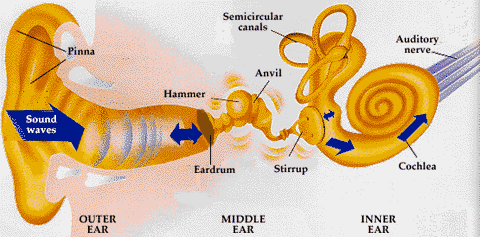


| Title: | Location | K-4 | 5-8 | 9-12 | Description | Discipline |
| Outer Ear | SoundGarden | How is sound transformed so we can hear it? |
TIP: you will need to use both a set of stereo headphones and the speakers on your multimedia computer to properly hear these effects. Make sure the volume isn't too loud!
Your Pinna and Ear Canal
Take a moment and follow the path of the ridges of one of your ears with your finger. What do you think all of those curves designed to do?
Try this:
As the sound plays:
- cup your hands over your ears for several seconds.
- now cup them backward. What's different?
- next, gently press on the small flap and cover one ear, then the other. What happens? Describe the differences in your journal.
Your Eardrum
Some sounds are so loud that you can actually feel them. Thunder, fireworks, rock music are strong enough that you can sense them through your skin. Since all sounds are vibrations they cause the objects they strike to vibrate.
Usually sound vibrations are heard not felt. Your eardrum is a thin flexible tissue that vibrates when sound strikes it. Can you imagine what it would feel like to be an eardrum? How fast or slow would you vibrate? How loud or how soft would you need to vibrate to create a sound?
Try this:
 (37") – now listen to the same sound on headphones. Make sure that you don't change the volume!
(37") – now listen to the same sound on headphones. Make sure that you don't change the volume!
What is the difference between the headphones and the speakers? Which one sounds louder? Write your answers down in your journal.
Hands-On! Activity – Make Your Own Eardrum

Materials Needed:
- 12 inch (or larger) cardboard tube
- balloon
- rubber band
To Do:
- Cut a piece of balloon large enough to fit over one end of the tube.
- Stretch the balloon over the tube and use a rubber band to secure the balloon.
- If you wish, decorate the outside of the tube.
- Now, talk into the tube and feel the balloon at the end with your fingers.
- Try making different sounds, like singing, shouting, a machine, etc.
- Now, say the words "la la la la la" then say the words "once upon a time in a land far, far away."
- Compare the way the balloon vibrates. How is it different or the same?
- What other experiments can you think of? Try them!
[ Note: Be sure to save your eardrum for the middle ear activity! ]
What's the Point?

The Auditory Pathway
Your outer ear is designed to focus sound into the ear canal and send it to the eardrum. When sound energy strikes the eardrum, it in turn creates a faithful replica of the sound. The process changes sound energy from air waves into mechanical energy. This is the main purpose of your outer ear.
Just for Fun
Think of some of the different people and animal ears that exist. For example, Mr. Spock from the TV show Star Trek, or Dumbo the elephant, etc.
Design a new outer ear (pinna) on a sheet of paper. Cut it out and fit it over your own ear. How does it change the way you hear?
"I have a reasonable good ear in music:
let us have the tongs and bones."
– William Shakespeare
Send your comments to: webteam@cafemuse.com
© 1996 – 2013 NewWorldView, All Rights Reserved.